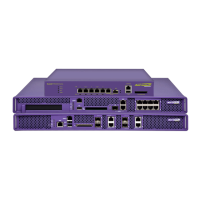AP Management from Controller
Summit WM3000 Series Controller System Reference Guide488
How the AP Receives its Configuration
An AP does not require a separate "local" or "running" configuration. Once adopted, the AP obtains its
configuration from the controller. If the AP to controller link fails, it continues to operate using the last
valid configuration until its link is re-established and a new configuration is pushed down from the
controller. There is no separate file-based configuration stored on the controller.
Only WLAN, VLAN extension and radio configuration items are defined for the AP by its connected
controller. None of the other access point configuration items (RADIUS, DHCP, NAT, Firewall etc.) are
configurable from the connected controller.
After the AP downloads a configuration file from the controller, it obtains the version number of the
image it should be running. The AP image can be downloaded from the controller or independently
outside of controller. If there is still an image version mismatch between what the controller expects and
what the AP is running, the controller will deny adoption.
=When configuring wireless settings for APs all configuration must be done through the controller and not from the
AP management console. Making changes directly in the AP management console can lead to unstable operation of
the AP.
AP Adoption Pre-requisites
Adopting an AP3510 model access point requires:
● The appropriate controller licenses providing AP functionality on the controller.
● The correct password to authenticate and connect the AP to the controller (feature dependent).
Configuring the AP for Adoption by the Controller
To configure an AP for controller adoption:
1 An AP needs to find and connect to the controller. To ensure this connection, conduct one of the
following:
● Configure the controller’s IP address on the AP.
● Provide the controller IP address using DHCP option 189 on a DHCP server. The IP address is a
comma delimited string of IP addresses. For example "157.235.94.91, 10.10.10.19". There can be a
maximum of 12 IP addresses.
● Configure the controller’s FQDN on the AP. The AP can use this to resolve the IP address of the
controller.
2 Use the controller’s secret password on the AP for the controller to authenticate it.
To avoid a lengthy broken connection with the controller, Extreme Networks recommends generating
an SNMP trap when the AP loses adoption with the controller.
For additional information (in greater detail) on the AP configuration activities described above, see “AP
Configuration” on page 489.

